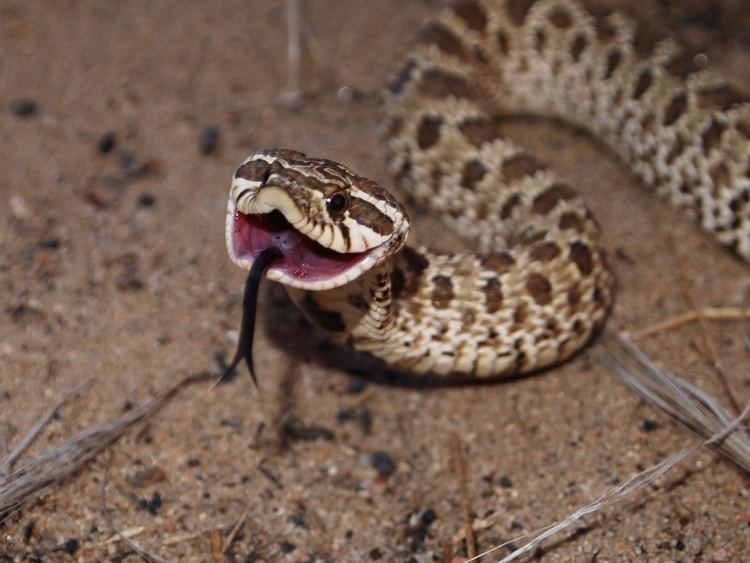 | ||
Representative species Western hognose snake, Eastern hognose snake, Southern hognose snake, Lystrophis, Leioheterodon madagascariensis | ||
Hognose snake is a common name for several colubrid snake species with upturned snouts. They include three distantly related genera:
Contents
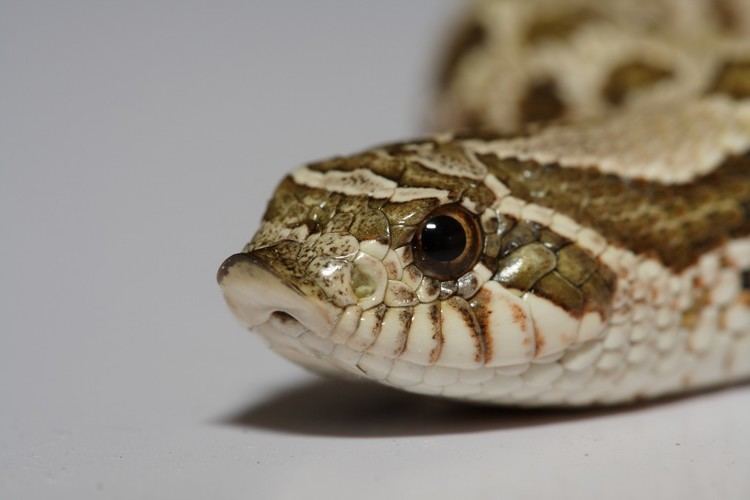
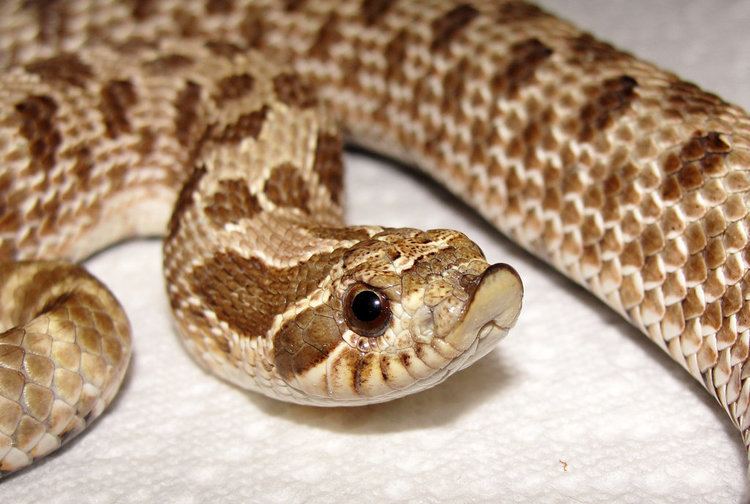
The North American Heterodon species are known for their habit of thanatosis: playing dead when threatened.
How to care for a western hognose snake
Species
Genus Heterodon:
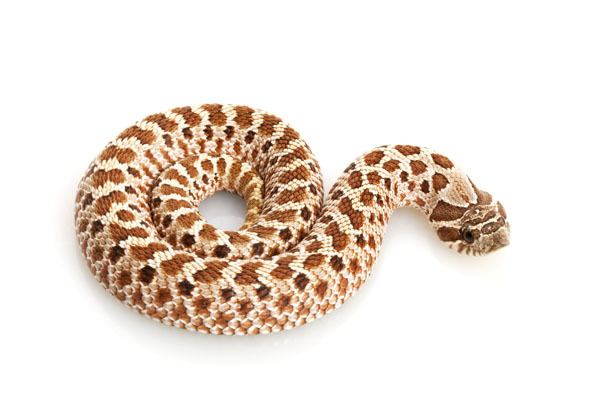
Genus Leioheterodon:
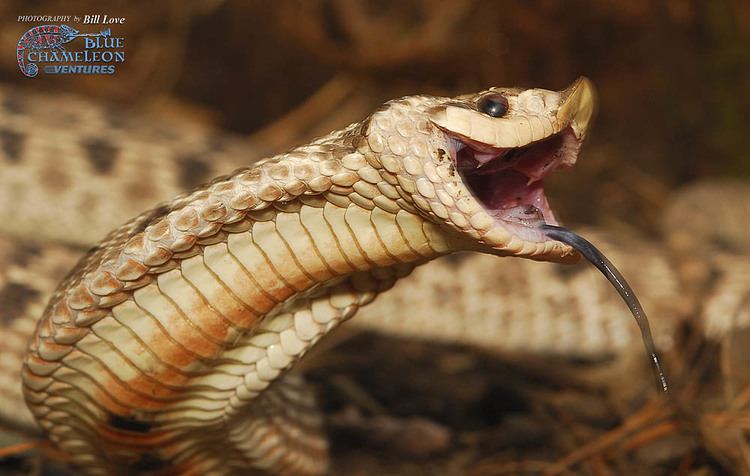
Genus Lystrophis:
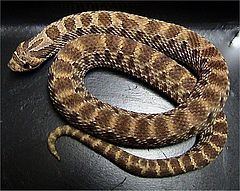
Description
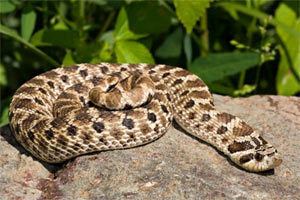
Hognose snakes' most distinguishing characteristic is their upturned snout, which aids in digging in sandy soils by using a sweeping, side to side motion. They also like to burrow in masses of humus. Lieoheterodon species are known to dig up the eggs of lizards.
Hognose snakes are extremely variable in color and pattern. Heterodon nasicus and H. kennerlyi tend to be sandy colored with black and white markings, while H. platirhinos varies from reds, greens, oranges, browns, to melanistic (i.e. black) depending on locality. They are sometimes blotched and sometimes solid-colored. Leiohetereodon geayi is a brown or tan colored snake with dark speckling on it. Leioheterodon madagascariensis is typically green and yellow with a black checkerboard pattern along its back. Leioheterodon modestus is normally a gold-brown color. Some species in the genus Lystrophis are referred to as tri-color hognose snakes and sometimes as false coral snakes because they display alternating bands of red, white, and black.
Leioheterodon are the largest of the hognose snakes, capable of reaching lengths of 1.8 m. Heterodon platirhynos gets slightly larger than other species of the genus, reaching lengths of 80 cm, where other species in the genus as well as Lystrophis species usually average around 65 cm at adult size.
Hognose snakes (Heterodon) are rear-fanged. The fangs have been referred to as just "enlarged teeth", but they are genuine fangs that are used for prey restraint. Despite the common belief, there is no evidence to support the fangs being used for "toad popping". Under this belief, the toads inflate their lungs to make swallowing difficult, but the fangs would penetrate the lungs and deflate them. However, whole toads with intact lungs are commonly regurgitated by recently captured hognoses.
Behavior
When threatened, hognose snakes will hiss, flatten their necks and raise their heads off the ground like cobras. They sometimes feign strikes, but actual Heterodon bites are very rare. This behaviour has earned them local common names such as "puff adder", "blowing adder", "flathead", "spreadhead", "spreading adder" or "hissing adder". Note: For Heterodon, "puff adder" is a common name inconsistent with established usage. "Puff adder" is the accepted common name of Bitis arietans, an unrelated, dangerously venomous, African species of viper, which incidentally does not flatten its neck in any threat display.
If this threat display fails to deter a would-be predator, Heterodon species often roll onto their backs and play dead, going so far as to emit a foul musk and fecal matter from their cloaca and let their tongues hang out of their mouth, sometimes accompanied by small droplets of blood. If they are rolled upright while in this state, they will often roll back as if insisting they really are dead. It has been observed that the snake, while appearing to be dead, will still watch the threat that caused the death pose. The snake will 'resurrect' sooner if the threat is looking away from it than if the threat is looking at the snake.
They are rather timid snakes and commonly hide from predators by burrowing down into leaves, sand etc.
Diet
Heterodon are diurnal active foragers that typically consume their prey live without any constriction or body pinning, primarily relying on only their jaws to subdue their prey.
For most hognose snakes the bulk of the diet is made up by rodents, and lizards. Heterodon platirhinos is an exception, and specializes in feeding on toads although other food items such as eggs, insects and mice can make up as much as 50% of their diet.
In captivity
Hognose snakes are frequently found in herpetoculture. Heterodon nasicus are often considered to be the easiest to care for, and captive bred stock is easily found. Heterodon platirhinos is also commonly found, but their dietary requirements can be a challenge for some keepers, and there is anecdotal evidence to suggest that feeding them a diet of exclusively rodents contributes to liver problems and a shortened life span. Leioheterodon species are imported regularly from Madagascar, and are not often bred in captivity and get much larger, so can pose a set of different challenges for care. Lystrophis species are fairly new to the commercial reptile trade, and are now commonly bred in captivity, but can be some of the more expensive hognose snakes available.
Toxicity
There has been some debate about whether hognoses are venomous. Their saliva meets the definition of venom since it is toxic to small prey such as frogs and toads; however, it is not likely to cause serious injury to humans, particularly as hognoses are rear-fanged and although they will generally feign a strike they will bite if they feel threatened.
